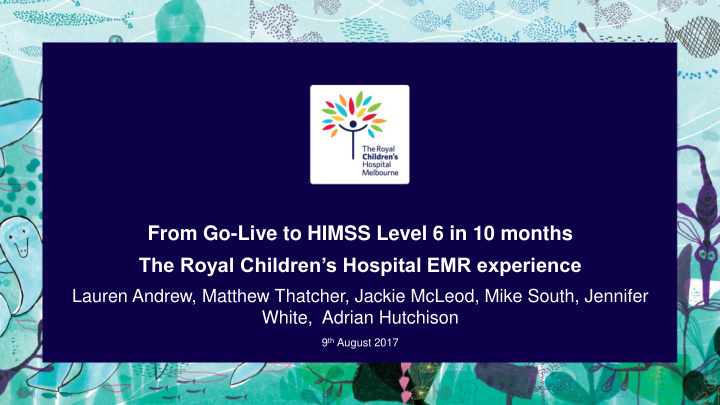



From Go-Live to HIMSS Level 6 in 10 months The Royal Children’s Hospital EMR experience Lauren Andrew, Matthew Thatcher, Jackie McLeod, Mike South, Jennifer White, Adrian Hutchison 9 th August 2017
Royal Children’s Hospital
RCH cannot aspire to be a GREAT children's hospital, leading the way, if it continues to rely on paper-based records and antiquated systems for communications and patient care transactions.
Why Epic? Most advanced software (KLAS reports) Best vendor partner model Most suited for academic paediatric hospital Extensive background investigation Our staff chose Epic: Tender evaluation: Clinical 50% - Over 250 staff attended tender demonstrations Technical 17.5% - Over 70 staff, formal tender evaluation process Implementation 17.5% Tenderer Capability 10% Contract 5%
What was in scope?
Device integration 220 fixed bedside monitors Ventilators NICU / PICU
Point of Care equipment Computer On Wheels Hand held android device - Rover Mounting solutions iPads Laptops at home services – car charges 23’ screens Label printers – medications Barcode scanners Desktop printers Touch screens anaesthetics
Portals – patient & family See & Request changes to appointments See allergies / immunisations See medications and request repeats See test results (8 day auto release) See clinic notes / correspondence Self scheduling – pilot commenced Messaging clinicians – coming soon Questionnaires – coming soon
Sharing care
Integration 22 interfaces Internal & External Systems JCAPS – integration engine HL7 2.4.1
Research Subject identification / recruitment Research coordinator notification Routine & study data collection Family portal data collection Embedded analytics Data warehouse
Why big bang?
Why big bang? Patient safety focus • Clear cutover plan from paper to EMR for current inpatients • All documentation to be completed in the EMR • All clinical documentation available in one place EMR Workflows were built to support patient flow across all areas
Why big bang? • From an organisational perspective -Organisation focus for one period -More efficient to concentrate support to one period of time, not two -Reduce fatigue for the project team. -It was more cost effective
What does it take to deliver? • 30 clinical systems replaced or integrated • Millions of records migrated from legacy systems • 2600 computers checked prior to go live • 3,785 staff trained with over 20,000 hours of training delivered • 100+ Epic experts at go live from the RCH EMR team & Epic staff • 400+ super users all from RCH staff volunteering to take shifts to help out their colleagues
Success factors - methodology
Success factors - team EMR team The RCH team Many analysts were RCH clinicians Governance committees External recruits to fill skill gaps Clinical decision making Emphasis on training – mandatory Management team Recruitment to EMR advisors (Drs), trainers, super users positions Vendor support team Strong onsite support from Epic Strong support model from Verona
Success factors - governance • Strong internal governance structure • Commitment from all levels • Executive leadership • Managers program • Focus on EMR project
Success factors – readiness Go live readiness program • 30, 60, 90, 120 day Go live checklists for managers Technical and clinical dress rehearsals
Success factors – go-live The system: For staff: 24/7 support for 4 weeks 24/7 support for 5 weeks EMR Command Centre Super user support centre • - Staffed by EMR trainers EMR and IT Help Desk co- - 400 super users – connected to located EMR by WhatsApp • 4206 Help Desk jobs logged 19,000 messages in first 5 weeks • 95% resolution rate Support from Epic and Stanford • Focus on addressing Children’s Health technical issues Reduced activity in outpatients and theatres
Go live supports • Top 10 @ 10 with Executive team • Executive rounding • Daily Patient Safety Meetings • Monitored all reported incidents • Quality and Safety dashboards
HIMSS 2017 2012
Benefits - clinicians Information all in one place • Fast • Easy to find • Clear overview of whole patient • Specialty level customisation One logon/password Remote access – PC / iPad / phone
Benefits - productivity 2015/2016 2016/2017 Variance Number of multiday stay 21322 21062 -1.23% patients Number of same day patients 23357 27593 15.35% Average LOS 2.64 2.56 -3.12% Number of outpatients 184705 193679 4.6%
Reduction in testing 2015/2016 2016/2017 Variance Total pathology 1235500 1228732 -5.50% tests completed Total medical 88406 85992 -2.80% imaging examinations
Quality & Safety - examples • Improved patient identification through barcode scanning • Improvement in completion of transfusion consent • Improved management of specialist clinic wait list • Improved compliance in state government CPE (bacteria) screening guidelines
Financial benefits • 87% reduction in transcription and costs • Savings from ‘ sunsetted ’ software • 32% reduction in pre-printed form costs • 6.3% reduction in senior medical recall • Increased revenue due to improved compliance – PBS scripts, MBS referrals • 8.3% increase private patient revenue • 12.4% increase in prosthetic revenue • 4.6% increase in outpatient revenue
Future Benefits • Adherence to standardised care – Review data on variance from CPG for diagnoses • Increase sophistication of Best Practice Advisories • Guide use of Criteria Led Discharge • Full closed loop medication and unit dose dispensing • Implement additional Epic applications
Thank You Contact: matt.thatcher@rch.org.au
Recommend
More recommend